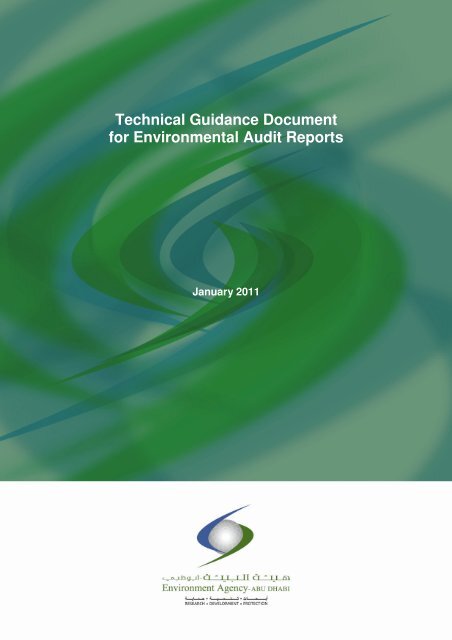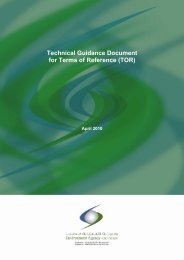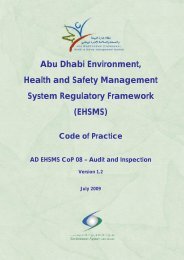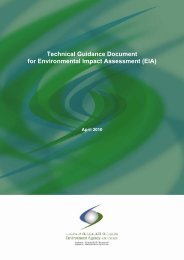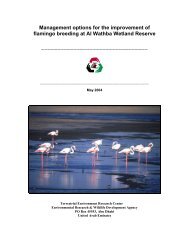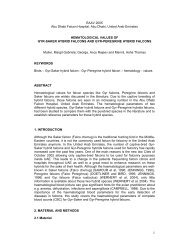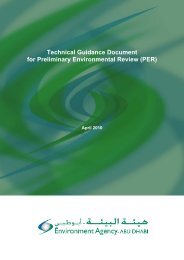Technical Guidance Document for Environmental Audit Reports
Technical Guidance Document for Environmental Audit Reports
Technical Guidance Document for Environmental Audit Reports
- No tags were found...
Create successful ePaper yourself
Turn your PDF publications into a flip-book with our unique Google optimized e-Paper software.
<strong>Technical</strong> <strong>Guidance</strong> <strong>Document</strong> <strong>for</strong> <strong>Environmental</strong> <strong>Audit</strong> <strong>Reports</strong>List of AbbreviationsCEMPEADEAPEAREIAEMSNOCOEMPConstruction <strong>Environmental</strong> Management PlanEnvironment Agency–Abu Dhabi<strong>Environmental</strong> Action Plan<strong>Environmental</strong> <strong>Audit</strong> Report<strong>Environmental</strong> Impact Assessment<strong>Environmental</strong> Management SystemNo Objection CertificateOperation <strong>Environmental</strong> Management Plan<strong>Document</strong> Tracking Number: 03.02.377.WP.03Date of Issue: 06Jan11iv
<strong>Technical</strong> <strong>Guidance</strong> <strong>Document</strong> <strong>for</strong> <strong>Environmental</strong> <strong>Audit</strong> <strong>Reports</strong>Definition of Terms<strong>Audit</strong>—A systematic, independent, and documented review of operations and practises to ensure thatrelevant requirements are met. Qualified professionals with relevant auditing experience shouldconduct audits and, where possible, independent external auditors should also be used.<strong>Audit</strong> Conclusion—Outcome of the audit provided by the auditor after consideration of the auditobjectives and all audit findings.<strong>Audit</strong> Criteria—The set of policies, procedures, or requirements used as a reference during an audit.<strong>Audit</strong> Evidence—Records, statements of fact, or other in<strong>for</strong>mation that are relevant to the auditcriteria and verifiable.<strong>Audit</strong> Findings—Results of the evaluation of the collected audit evidence against audit criteria. <strong>Audit</strong>findings can indicate either con<strong>for</strong>mity or noncon<strong>for</strong>mity with audit criteria.Construction—The time period that corresponds to any event, process, or activity that occurs duringthe Construction phase (e.g., building of site, buildings, processing units) of the proposed project.This phase terminates when the project goes into full operation or use.Corrective Action Plan—An action plan developed by the proponent, contractor, or facility ownerand approved by the external auditor that describes how the contractor or facility owner intends toresolve the non-con<strong>for</strong>ming item. The Corrective Action Plan should be specific, measurable,achievable, realistic, and timely. Note that the Environment Agency–Abu Dhabi (EAD) does notrequire that a Corrective Action Plan be submitted <strong>for</strong> review and approval be<strong>for</strong>e implementing acorrective action process.Construction <strong>Environmental</strong> Management Plan—A document developed by an EAD–approvedenvironmental consultant and approved by EAD prior to the commencement of construction activities.The Construction <strong>Environmental</strong> Plan (CEMP) outlines the possible impacts to the environment fromthe construction activities and describes mitigation actions that should be conducted to reduce theenvironmental impacts of these activities.Environment Agency–Abu Dhabi—The legal authority in Abu Dhabi Emirate pertaining to theprotection of the environment as decreed in Federal Law No. 24 of 1999.<strong>Environmental</strong> Action Plan—A comprehensive plan that is submitted to EAD <strong>for</strong> review andapproval to ensure that appropriate corrective and preventive action measures are taken to resolveproblems identified during internal and/or external inspections and audits. EAD may require that an<strong>Environmental</strong> Action Plan be prepared and submitted <strong>for</strong> review and approval when an inspection orincident identifies an issue that has impacted or has the potential to impact human health or theenvironment.<strong>Environmental</strong> <strong>Audit</strong> Report—A summary report prepared after an environmental audit thatdescribes the attributes of the audit and the audit findings and conclusions.<strong>Environmental</strong> Component—An attribute or constituent of the environment (i.e., air quality; marinewater; waste management; geology, seismicity, soil, and groundwater; marine ecology; terrestrialecology; noise; traffic; socio-economic) that may be impacted by the proposed project.<strong>Environmental</strong> Impact—A positive or negative condition that occurs to an environmentalcomponent as a result of the activity of a project or facility. This impact can be directly or indirectlycaused by the project’s different phases (i.e., Construction, Operation, and Decommissioning).<strong>Document</strong> Tracking Number: 03.02.377.WP.03Date of Issue: 06Jan11v
<strong>Technical</strong> <strong>Guidance</strong> <strong>Document</strong> <strong>for</strong> <strong>Environmental</strong> <strong>Audit</strong> <strong>Reports</strong>External <strong>Audit</strong>—An assessment of site works, processes, and <strong>Environmental</strong> Management Systemsby an EAD–approved third-party environmental consultant. The external audit assesses complianceagainst the specific requirements levied by EAD or other regulatory authorities (e.g., permit, CEMP,Operation <strong>Environmental</strong> Management Plan).Non-con<strong>for</strong>mance—Issues that are in direct non-compliance with the requirements of permits, theNo Objection Certificate, and/or the CEMP and that constitute a serious threat to the environmentalconditions onsite. All non-con<strong>for</strong>mances require the development of a Correction Action Plan <strong>for</strong>approval and implementation.Minor Non-con<strong>for</strong>mance—Less significant issues that do not cause a significant threat to theenvironment and can be remediated quickly and easily. The issue still requires a corrective action tobe developed by the contractor to ensure that the issue does not escalate.Major Non-con<strong>for</strong>mance—Significant issues observed onsite that are causing or have the potentialto cause major environmental or health damage or are resulting in the ineffective implementation ofthe environmental controls onsite. A major non-con<strong>for</strong>mance may result from the occurrence ofrepeated or habitual minor non-con<strong>for</strong>mance.Observation—Minor issues that have been noted onsite that do not typically represent an immediatethreat to the environment. However, these issues represent areas of poor environmental managementonsite and have the potential to escalate to non-con<strong>for</strong>mance issues in the future.Operation—The time period that corresponds to any event, process, or activity that occurs during theOperation (i.e., fully functioning) phase of the proposed project or development. (The Operationphase follows the Construction phase, and then terminates when the project or development goes intothe Decommissioning phase.)Operation <strong>Environmental</strong> Management Plan—A site-, project-, or facility-specific plan developedto ensure that environmental management practises to eliminate and control environmental impactsare followed during Commissioning and Operation phases.Proponent—The person, company, or agency that is the primary responsible party <strong>for</strong> a developmentproject and that is the permit applicant/holder <strong>for</strong> the project.<strong>Document</strong> Tracking Number: 03.02.377.WP.03Date of Issue: 06Jan11vi
<strong>Technical</strong> <strong>Guidance</strong> <strong>Document</strong> <strong>for</strong> <strong>Environmental</strong> <strong>Audit</strong> ReportPurpose of This <strong>Technical</strong> <strong>Guidance</strong> <strong>Document</strong>This <strong>Technical</strong> <strong>Guidance</strong> <strong>Document</strong> outlines the requirements <strong>for</strong> developing an <strong>Environmental</strong> <strong>Audit</strong>Report (EAR) <strong>for</strong> submission to the Environment Agency–Abu Dhabi (EAD) <strong>for</strong> review andapproval. This document is intended to provide guidance to project proponents, facility owners, andconsultants on the preparation of an appropriate report following an environmental audit. Particularly,this guidance document provides an overview of the proper <strong>for</strong>mat and contents of an EAR to meetEAD’s requirements, help the proponent/consultant prepare this report, make the review processeasier and consistent <strong>for</strong> EAD.Section I of this <strong>Technical</strong> <strong>Guidance</strong> <strong>Document</strong> provides background in<strong>for</strong>mation, the definition of anEAR, the objectives of an EAR, and in<strong>for</strong>mation on how to prepare and submit an EAR. Section IIdescribes the contents and <strong>for</strong>mat of an appropriate EAR.Section I. Background In<strong>for</strong>mationAn environmental audit is a tool used by EAD to provide oversight of the management ofenvironmental impacts from development projects and industrial activity. The EAR is a summaryreport that provides the findings from the environmental audit. The EAR is required to be submitted toEAD <strong>for</strong> review and approval on a periodic basis as outlined in a permit, a Construction<strong>Environmental</strong> Management Plan (CEMP), an Operation <strong>Environmental</strong> Management Plan (OEMP),or another EAD–required document. The following sections provide more detail on the definition,objectives, and preparation and submission requirements of an EAR.Definition of an <strong>Environmental</strong> <strong>Audit</strong> ReportAn EAR documents an independent, accurate, and detailed assessment of environmental per<strong>for</strong>mance<strong>for</strong> a development project or industrial facility. An EAR describes the project or process beingaudited, lists the environmental audit findings associated with that project or facility, details the auditprocedures that were followed, and identifies the relevant environmental requirements that were usedduring the assessment. The EAR is used to assess the implementation of a project’s or facility’s<strong>Environmental</strong> Management System (EMS) and compliance with EAD–issued permits, certificates,licences, or approved plans (e.g., CEMP, OEMP). Accordingly, audit reports should be clear, timely,concise, and objective; provide a fair summary of all the relevant facts; and demonstrate con<strong>for</strong>mitywith the related EAD–approved environmental studies. <strong>Audit</strong> issues that have been reported should beproperly analysed and concluded, and all reported findings and conclusions should be supported byadequate, reliable, and fair audit evidence.Objectives of an <strong>Environmental</strong> <strong>Audit</strong> ReportThe objective of an EAR is to provide interested parties (e.g., EAD) with a clear indication of theenvironmental per<strong>for</strong>mance or the project or facility <strong>for</strong> the period covered by the audit. The primaryobjectives of the EAR are as follows:Provide an objective analysis of the environmental impacts arising from a project or facilityEstablish that the requirements of the No Objection Certificate (NOC), CEMP, OEMP, andother <strong>Environmental</strong> Impact Assessment (EIA) are appropriately implementedDetermine that mitigation measures are effective in minimising or removing environmentalimpactsIdentify opportunities and make recommendations <strong>for</strong> improvements in environmentalper<strong>for</strong>mance of the project or facilityProvide the in<strong>for</strong>mation required to develop an <strong>Environmental</strong> Action Plan (EAP) in the eventof any significant findings of negative impacts to the environmentProvide an objective, third-party report that meets EAD’s requirements.<strong>Document</strong> Tracking Number: 03.02.377.WP.03Date of Issue: 6Jan111
<strong>Technical</strong> <strong>Guidance</strong> <strong>Document</strong> <strong>for</strong> <strong>Environmental</strong> <strong>Audit</strong> ReportThe findings and recommendations of the audit ef<strong>for</strong>t should be documented clearly and concisely inthe EAR. The usefulness of an EAR is measured by how well the problems are identified, evaluated,documented, and addressed by adequate and straight<strong>for</strong>ward mitigation measures and correctiveactions.Preparation and Submission of the <strong>Environmental</strong> <strong>Audit</strong> ReportThe proponent of a project or the facility owner is responsible <strong>for</strong> the EAR, which must be preparedand submitted by an EAD–approved and registered consultant who operates within Abu DhabiEmirate. A current list of registered consultants can be obtained from the EAD Web site. Theenvironmental audit must be conducted according to the scheduled frequency outlined by EAD in thefacility/project permit, NOC, CEMP, OEMP, or other directive, and the EAR must be submitted toEAD within 30 days of completion of the audit of the project or facility.Section II of this <strong>Technical</strong> <strong>Guidance</strong> <strong>Document</strong> provides an overview of minimum contents andrequired <strong>for</strong>mat of the EAR. This framework of in<strong>for</strong>mation presented should be followed <strong>for</strong> allEARs submitted; however, depending on the scope of the audit and particular issues identified, somesections of an EAR may be expanded or contracted as is relevant to the project or facility issues.Section II. <strong>Environmental</strong> <strong>Audit</strong> Report Contents and FormatThe EAR should communicate the relevant in<strong>for</strong>mation clearly and concisely and should there<strong>for</strong>eBe presented to make in<strong>for</strong>mation accessible to the non-specialist, avoiding technicalterminology where possibleHave in<strong>for</strong>mation presented in summary table <strong>for</strong>mat to the extent possible and use qualitymaps, charts, diagrams, and other visual aids whenever possibleBe presented in a logical and easy-to-understand manner, with a clear Table of Contents toallow the reader to find and assimilate in<strong>for</strong>mation quickly.Present in<strong>for</strong>mation without bias and discuss issues with the appropriate emphasis regardingtheir importance as in the overall context of the environmental audit.The following sections describe the minimum content and <strong>for</strong>mat requirements <strong>for</strong> an EAR.Table of ContentsThe EAR should have a title page and a Table of Contents. This Table of Contents should adhere tothe layout provided in Table 1. Note that the length and detail of the EAR may vary depending on thesize and nature of the project or facility being audited, or on the objectives and scope of the audit(e.g., whether it is an initial, surveillance, special audit); however, it is recommended that the EARfollow the <strong>for</strong>mat indicated as closely as possible. Following the <strong>for</strong>mat will allow EAD to provide aprompt and expeditious report review and minimise the potential <strong>for</strong> any submittals and clarificationsthat may be subsequently needed.Table of ContentsList of TablesList of FiguresList of AbbreviationsDefinitions of TermsTable 1. Standard Table of Contents <strong>for</strong> an EARChapter 1 Executive Summary 1.1 Project Title and Project Proponent1.2 Description of the <strong>Audit</strong>ed Development Project or Facility1.3 Description of the Environment1.4 Summary of Findings<strong>Document</strong> Tracking Number: 03.02.377.WP.03Date of Issue: 6Jan112
<strong>Technical</strong> <strong>Guidance</strong> <strong>Document</strong> <strong>for</strong> <strong>Environmental</strong> <strong>Audit</strong> ReportTable of ContentsChapter 2 Introduction 2.1 <strong>Audit</strong> Scope, Objectives, and Criteria2.2 <strong>Audit</strong>ors and <strong>Audit</strong>ees2.3 Reference <strong>Document</strong>sChapter 3 Site Activity Summary 3.1 Industrial Facilities3.2 Development ProjectsChapter 4 <strong>Audit</strong> Findings 4.1 <strong>Environmental</strong> Management Systems and ManagementCommitment4.2 Previous <strong>Audit</strong> Results4.3 Non-con<strong>for</strong>mances and Observations4.4 Summary of Corrective Action StatusChapter 5Conclusions andRecommendations<strong>Environmental</strong> <strong>Audit</strong> Report AnnexesAnnex 1Annex 2Annex 3Annex 4Photographic Record<strong>Audit</strong> Checklist(s)Supporting <strong>Document</strong>s<strong>Audit</strong> QualificationsThe Table of Contents should also include lists of tables and figures included within the body of thedocument.List of TablesThis section should include a list of all the tables presented within the main body of the EARand should indicate table numbers, table titles, and associated page numbers.List of FiguresThis section should include a list of all the figures presented within the main body of the EARand should indicate figure numbers, figure titles, and associated page numbers.Reference In<strong>for</strong>mationIn addition to the Table of Contents, the EAR should provide reference tables that allow <strong>for</strong> quickreference to abbreviations and definitions.List of AbbreviationsThis section should include a list of abbreviations and acronyms used in the EAR. This listshould be presented in a tabular <strong>for</strong>mat using a <strong>for</strong>mat similar to that on page iv of this<strong>Technical</strong> <strong>Guidance</strong> <strong>Document</strong>.Definitions of TermsThis section should include a list of terms used in the EAR and their definitions. Thisin<strong>for</strong>mation should be presented in a <strong>for</strong>mat similar to that used on page v of this <strong>Technical</strong><strong>Guidance</strong> <strong>Document</strong>.Chapter 1: Executive SummaryChapter 1 should summarise the overall scope and objective of the audit, the effectiveness of theproject EMS, the status of environmental per<strong>for</strong>mance, and the significant audit findings. With regardto audit scope, the EAD–approved or EAD–issued document that is the basis <strong>for</strong> the audit should beidentified with the directive title and date (e.g., construction permit, EIA, CEMP, OEMP). Anychanges in directives since the last audit should be identified and described (i.e., changes to CEMP).<strong>Document</strong> Tracking Number: 03.02.377.WP.03Date of Issue: 6Jan113
<strong>Technical</strong> <strong>Guidance</strong> <strong>Document</strong> <strong>for</strong> <strong>Environmental</strong> <strong>Audit</strong> ReportThe summary of the EMS should touch on the strengths and weaknesses of the management system,comment on particular highlights of the audit, and include an overview of any findings that representnon-con<strong>for</strong>mity and/or significant areas of concern.The Executive Summary should concisely and clearly state the conclusions of the audit regardingcon<strong>for</strong>mance of the project’s EMS against the EAD requirements and any recommendations orcorrective actions that are needed.The Executive Summary should be written in English only and include the following specificsections:1.1 Project Title and Project ProponentThis section should include the name, address, telephone number, and fax number of theproponent’s firm; the name and designation of the contact person who is responsible <strong>for</strong> theproject EMS; and the project’s title.1.2 Description of the <strong>Audit</strong>ed Development Project or FacilityThis section should contain short descriptions of the overall project or facility and thebreakdown of any phases or project/facility components, if applicable. The descriptionsshould be brief, yet provide enough in<strong>for</strong>mation <strong>for</strong> readers to understand the location, size,nature, and activity or function of the project or facility. Descriptions should includein<strong>for</strong>mation on the relevant management structures and work<strong>for</strong>ce, all inputs and outputs(industrial facility), and ancillary operations such as transport services, materials storage, andprocessing operations.1.3 Description of the EnvironmentThis section should include brief descriptions of the project’s or facility’s surroundings andon-site environment, including the natural and built environment, sensitive receptors, localecology (noting any sites of special interest or conservation value), and socio-economic orcultural factors that may have a bearing on the environmental impacts of the project orfacility.1.4 Summary of FindingsThe following in<strong>for</strong>mation and findings should be described in this section:A summary of non-con<strong>for</strong>mances and observations identified during the audit (the use oftables is recommended)A list of non-con<strong>for</strong>mances and observations, which are still on-going and not yet closed,that were identified in the previous audit reportsThe environmental impacts or issues observed during the course of the auditThe overall effectiveness of existing environmental mitigation measures and managementpractisesConclusions and recommendations, including any corrective actions required or taken.Chapter 2: IntroductionChapter 2 should provide in<strong>for</strong>mation on the audit scope, objectives, and the criteria used as the basis<strong>for</strong> the audit; identify background documents relevant to audit; identify the audit team members andthose representatives of the project or facility involved in the audit; and describe the audit itinerary.Sections 2.1 through 2.3 of this chapter describe the specific in<strong>for</strong>mation that should be included inthe Introduction.<strong>Document</strong> Tracking Number: 03.02.377.WP.03Date of Issue: 6Jan114
<strong>Technical</strong> <strong>Guidance</strong> <strong>Document</strong> <strong>for</strong> <strong>Environmental</strong> <strong>Audit</strong> Report2.1 <strong>Audit</strong> Scope, Objectives, and CriteriaThis section should describe the audit objectives, scope, and criteria used <strong>for</strong> the audit. Thissection would indicate the scope of the audit (e.g., if the audit covered the full developmentproject or facility, covered all environmental media or components, or was specificallytargeted to an issue or physical area of concern). The criteria on which the audit is basedshould be itemised and clearly identified (e.g., an EIA, CEMP, OEMP, construction permit,operating permit) with titles and dates. This section should also indicate if there have beenchanges in requirements applicable to the facility or project since the last audit or if therewere specific issues from <strong>for</strong>mer audits that would be considered.The typical scope items that should be described in the EAR <strong>for</strong> all projects and facilitiesinclude documentation and records, training, monitoring programmes and results, internalaudits and inspections, incidents and complaints, and audit activities. The specific in<strong>for</strong>mationthat should be included <strong>for</strong> those items is discussed below.<strong>Document</strong>ation and RecordsThe EAR should provide comments on the documentation and control of records,including CEMP and OEMP documents, permits, training records, environmentalprogramme plans and procedures, audit and inspection reports, and other records.TrainingThe EAR should describe and provide comments on the environmental trainingprogrammes that are being implemented in accordance with CEMP or OEMPrequirements.Monitoring Programmes and ResultsThe EAR should identify monitoring programmes that are being implemented on theproject and provide comment on whether monitoring is being per<strong>for</strong>med inaccordance with CEMP or OEMP requirements.Internal <strong>Audit</strong>s and InspectionsThe EAR should provide comment on the internal audit and inspection programmesthat are being implemented to meet regulatory requirements.Incidents and ComplaintsThe EAR should provide comment on the procedures followed <strong>for</strong> responding toincidents and/or complaints and include a description of any follow up on specificcomplaints or emergency response incidents.<strong>Audit</strong> Activities<strong>Audit</strong> activities include descriptions of audit interviewees and the timing and auditmethodologies used. This section would also include comments on the site conditionsduring the time of the audit, highlight any adverse conditions or unusual observationsmade, and identify areas of the site visited. The audit activities should focus onimplementation of the environmental programmes, procedures, and measuresidentified in the CEMP or OEMP. The typical environmental programmes or plansthat would be evaluated in the audit and discussed in the EAR are as follows:Air Quality Control PlanWater Quality Control PlanWaste Management Plan<strong>Document</strong> Tracking Number: 03.02.377.WP.03Date of Issue: 6Jan115
<strong>Technical</strong> <strong>Guidance</strong> <strong>Document</strong> <strong>for</strong> <strong>Environmental</strong> <strong>Audit</strong> ReportSoil and Groundwater Contamination Control PlanMarine Ecology Control PlanTerrestrial Ecology Control PlanNoise and Vibration Control PlanTraffic Management PlanErosion and Sediment Control PlanOther <strong>Environmental</strong> Programmes.2.2 <strong>Audit</strong>ors and <strong>Audit</strong>eesThis section should identify the personnel of the proponent, the facility, or consultantorganisation that per<strong>for</strong>med the audit (audit team). This section should also list the project orfacility representatives who were key contacts <strong>for</strong> the audit and describe their roles andresponsibilities with regard to the audit.2.3 Reference <strong>Document</strong>sThis section should include a list of documentation reviewed prior to the audit (e.g., CEMP,previous EARs, environmental assessments, permits, complaints). This section should alsoidentify the requirements on which the audit is based, indicating the title, version, and date ofany documents that contain site-specific environmental requirements. If changes to therequirements since the last audit were noted, then these should be described, relevant to thecurrent audit scope and objectives.Chapter 3: Site Activity SummaryChapter 3 should include detailed descriptions of the activities and processes that were beingconducted onsite during the audit. Contents of this chapter will depend on whether the audit is of anindustrial facility or a development project. For industrial facilities, this chapter should provide ageneral description of production processes, production levels, ancillary operations, and any otherin<strong>for</strong>mation that would relate to the activities or operations that would impact or contribute toenvironmental issues or concerns within the scope of the audit. Sections 3.1 and 3.2 below providemore in<strong>for</strong>mation on the contents of this chapter.3.1 Industrial FacilitiesIt is important to note that this section will be similar to the previous audit report <strong>for</strong> industrialfacilities and should focus on changes to operations that have occurred since the last audit.With regard to facility audits, the following in<strong>for</strong>mation should be included in this section.Main operationsThis in<strong>for</strong>mation would include descriptions of the type of facility (e.g.,manufacturing, power plant, chemical storage/distribution), the type of operationsconducted, (e.g., chemical blending, batch concrete mixing, metal fabrication,cogeneration steam/electric); and the production level or capacity (e.g., full capacity,100,000 tons of concrete/year, 20 MKw). These descriptions should be concise andbrief enough to provide the reader with an understanding of the size and complexityof the operations conducted onsite, both in comparison to facility capacity and inrelation to other similar type facilities.Ancillary operationsThis in<strong>for</strong>mation would include any particular operations that are not part of the mainfacility operations that would have impact or contribute significantly to the facility’spotential environmental impacts. This in<strong>for</strong>mation would include operations such as<strong>Document</strong> Tracking Number: 03.02.377.WP.03Date of Issue: 6Jan116
<strong>Technical</strong> <strong>Guidance</strong> <strong>Document</strong> <strong>for</strong> <strong>Environmental</strong> <strong>Audit</strong> Reportvehicle or equipment servicing, large electrical switch yards, and large chemicalstorage or staging areas.<strong>Environmental</strong> control operationsThe EAR should describe any specific engineered or work practise controls that are inplace to mitigate environmental pollution that would be within the scope of the audit(e.g., wastewater treatment plant, air pollution–control devices).3.2 Development ProjectsFor development projects, this section should describe the progress or phase of the projectconstruction activity, including the contractors that were present onsite and their individualactivities, and the status of the project against the overall project schedule. For developmentprojects, this section will differ from the last audit because this section will reflect the currentactivity onsite and should reflect the changes that have occurred from previous phases orstages of the development project. With regard to development projects, in<strong>for</strong>mation on statusand schedule, as well as descriptions of the contractors and the activity should be included inthis section.Status and ScheduleThe EAR should describe the current status of project implementation and theschedule of the project and the components and phases therein (if it is a multicomponentor a multi-phased project). Notes should be made regarding any changesmade to the schedule and the anticipated schedule of the project.Contractors and Activity DescriptionsThis EAR section should describe and provide details on the main contractor andsubcontractors and their responsibilities with regard to EMS activities and projectactivities, particularly if changes have occurred since the last audit. The in<strong>for</strong>mationpresented in this section should reference the activities outlined in the CEMP orOEMP. At a minimum, the in<strong>for</strong>mation should cover on the following activities:Waste and wastewater managementHazardous materials managementMaterial and equipment managementWater and groundwater managementEnergy managementNoise managementAir quality control.Chapter 4: <strong>Audit</strong> FindingsThis chapter should provide an overview of audit findings, including any analysis of the noncon<strong>for</strong>mancesnoted. In particular, this chapter should describe findings regarding the implementationof EMSs and the resolution (or non-resolution) of previous audit findings and thoroughly discussindividual audit findings. The preferable <strong>for</strong>mat <strong>for</strong> presenting the individual audit findings is intabular <strong>for</strong>m, which includes whether the finding has been addressed by corrective action. Sections4.1 through 4.4 below provide more in<strong>for</strong>mation on the contents of this chapter.4.1 <strong>Environmental</strong> Management Systems and Management CommitmentThis section should provide comments on the facility’s or proponent’s procedures <strong>for</strong>determining, setting, and communicating environmental policies and objectives, as well as theoverall commitment of senior management to meeting environmental requirements. Included<strong>Document</strong> Tracking Number: 03.02.377.WP.03Date of Issue: 6Jan117
<strong>Technical</strong> <strong>Guidance</strong> <strong>Document</strong> <strong>for</strong> <strong>Environmental</strong> <strong>Audit</strong> Reportin this discussion would be the facility’s or proponent’s ef<strong>for</strong>ts to monitor, measure, andreport environmental per<strong>for</strong>mance.4.2 Previous <strong>Audit</strong> ResultsThe EAR should provide comments on the facility’s or proponent’s mechanisms to determinethe root causes of any previously identified environmental problems and on the effectivenessof the actions taken to correct such situations and prevent their recurrence. This sectionshould also comment on the sufficiency of the facility’s or proponent’s <strong>for</strong>mal processes <strong>for</strong>implementing and tracking corrective and preventive actions.4.3 Non-con<strong>for</strong>mances and ObservationsThis section should contain a table identifying non-con<strong>for</strong>mances and observations identifiedduring the current audit, sorted by priority, and should include the following in<strong>for</strong>mation:Description of each non-con<strong>for</strong>mance or observation, including a unique referencenumber <strong>for</strong> each non-con<strong>for</strong>mance or observation to ease follow-up in subsequent auditreports and to help in tracking the corrective action statusDate of occurrence<strong>Audit</strong> criterion or the specific NOC, CEMP, OEMP, or regulatory requirement applicableto the non-con<strong>for</strong>manceRelative priority or significance of the finding with respect to EAD and regulatoryrequirements (e.g., major, minor, observation)Details (e.g., coordinates) regarding where the non-con<strong>for</strong>mity or observation was foundSubcontractor that caused the non-con<strong>for</strong>mance (if applicable).The description of the non-con<strong>for</strong>mances should be concise, yet be sufficiently broad orsupported by documentation, photographs, or other in<strong>for</strong>mation (to be included in the EARannex) to allow project or facility management to address the issue and EAD to assessadequate resolution of the issue.4.4 Summary of Corrective Action StatusThis section should include a summary table that provides details on the corrective action(s)taken and/or planned in response to non-con<strong>for</strong>mances and/or the observations identified inSection 4.3 above. This section should also include any corrective actions planned or taken toaddress non-con<strong>for</strong>mances identified in recent previous audits, particularly those that havebeen or are ongoing issues at the site or facility. In particular, the Corrective Action Plansummary should include the type of any required corrective action, the current status (e.g.open, closed) of corrective action(s), the date of planned closure, and the date of actualclosure as a result of conducting the audit follow-up. This section should provide commentson the auditor’s observation on the capability and commitment of the site/facility managementto resolve the issues.It is important to note that EAD may require the facility or project to develop an EAP if issuesare identified in the audit that are considered to be repetitive or are ongoing issues, orproblems that present significant concern <strong>for</strong> environmental impact. The EAP is a CorrectiveAction Plan that must be submitted and approved by EAD and requires <strong>for</strong>mal reporting ofthe resolution of the issues. Additional in<strong>for</strong>mation regarding the requirements <strong>for</strong> developingan EAP can be found on the EAD Web site in the document titled EAD <strong>Technical</strong> <strong>Guidance</strong>:<strong>Environmental</strong> Action Plan, April 2010.<strong>Document</strong> Tracking Number: 03.02.377.WP.03Date of Issue: 6Jan118
<strong>Technical</strong> <strong>Guidance</strong> <strong>Document</strong> <strong>for</strong> <strong>Environmental</strong> <strong>Audit</strong> ReportChapter 5: Conclusions and RecommendationsChapter 5 should include the conclusions of the audit with regard to the status of the con<strong>for</strong>mity of thesite or facility EMS with the CEMP, OEMP, or other requirements, as well as the effectiveness of theEMS in meeting environmental objectives.The EAR should make recommendations to address any significant non-con<strong>for</strong>mances or deficiencies,including allocating priorities <strong>for</strong> corrective action. Any recommendations should be specific anddetailed enough to allow EAD and facility/project management the ability to evaluate the feasibilityand appropriateness of implementing the recommendation. Types of recommendations might includefurther investigation of an issue or implementation of emissions control technology or environmentalpollution control best management practices. The emphasis of recommendations should be onremoving the source of the problem rather than the use of command-and-control (or end-of-pipe)technology.<strong>Environmental</strong> <strong>Audit</strong> Report AnnexesThe annexes of the EAR should include all in<strong>for</strong>mation necessary to support the findings of the auditthat are not provided in the main text of the EAR. Typical annexes should include the followingin<strong>for</strong>mation:Annex 1: Photographic Record—This annex should include evidence available to supportnon-con<strong>for</strong>mities identified in the report and/or corrective actions taken.Annex 2: <strong>Audit</strong> Checklist(s)—This annex should include reference materials such aschecklist(s) or audit protocol used by auditors.Annex 3: Supporting <strong>Document</strong>s—This annex should include other documents that support orprovide necessary clarity <strong>for</strong> audit findings or recommended corrective actions. Thesedocuments may include internal audit/inspection reports, monitoring reports, site or facilitymaps, technology descriptions, equipment specifications, waste transfer notes, Material SafetyData Sheets, reference materials <strong>for</strong> regulatory requirements, and/or best managementpractices.Annex 4: <strong>Audit</strong>or Qualifications—This annex should include in<strong>for</strong>mation about the auditteam members who provided evidence of knowledge and capability to conduct theenvironmental audit.Additional annexes should be added as needed to support Environment, Health, and Safetydocumentation and log templates <strong>for</strong> inspection, auditing, monitoring, maintenance, and training.<strong>Document</strong> Tracking Number: 03.02.377.WP.03Date of Issue: 6Jan119


